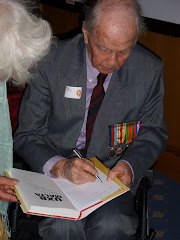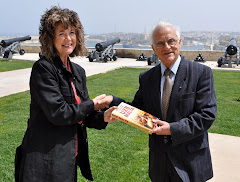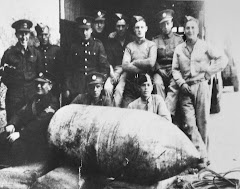A whole year on from my first attempt to find the records of Royal Engineers Bomb Disposal in Malta, I finally held in my hands the relevant War Diary. In my elation, I could never have envisaged the task ahead of me.
A War Diary is a daily log of the main events of each relevant unit. The Diary of the Fortress Engineers, Malta, describes work done by the various subsidiary Companies, as well as air raids, casualties and damage to their headquarters. The Bomb Disposal (BD) Report for each week was attached as an appendix to the War Diary.
The first document I saw with the signature of 'Lt Geo D Carroll' as Bomb Disposal Officer was the BD Report for the week ending 10 May 1941. It listed the 59 unexploded bombs dealt with that week, with details for each one: serial number and date of the UXB report, the location, nationality, size and type of bomb (eg 50kg SD), whether it was on the surface or how deep it was buried. The final column logged the date the bomb was rendered harmless, with a brief description of the action taken.
It was only then that the enormity of what I'd uncovered began to sink in. As I read page after page describing what had actually gone on compared to what I’d found in books, I realised that the ‘booklet’ I'd planned to write couldn't possibly do the story justice. I began to contemplate writing my first book.
I had unearthed a goldmine: detailed, day to day account of the actions of RE Bomb Disposal in Malta from 1940 to 1944, and of the environment they worked in. More than a thousand pages of information revealed endless air raids, and the resulting thousands of unexploded bombs that were dealt with. Thanks to the National Archives, I was allowed to take copies of the documents, so I could study them at home between return visits to collect more.
But now I had to work out what all this information could tell me; statistics and lists are meaningless without interpretation. I was used to handling research material in some detail but this was on a different scale altogether. I had to develop new skills and devote hours to collating it all. I began to wonder what kind of person I might have to become, in order to create this history! For once, the amount of rest demanded by my illness (see earlier blog) worked in my favour. I spent weeks transcribing the documents into MS Excel, so I could analyse the data. That way I could take an overview of any aspect, according to the story I had to tell or a question I needed to answer.
Locations were an interesting challenge: many of the UXB records carried a map reference instead of a place-name. Without access to the relevant military map, I worked out a grid from the references I had and drew it onto my own Malta map, so I could locate the bombs. The activity reminded me of a skeleton crossword puzzle. When I did eventually find a copy of the real map, I wasn’t far off. Now I could plot the reported UXBs, link them to actual air raids and understand the implications for their surroundings. With map in hand, I set off to Malta to ‘walk the course’.
As I write this, even I am beginning to wonder at my own persistence. No wonder it took me three years to get to the first draft. It was worth it. I emerged from the intense activity with a robust body of information from which to construct the book. As well as providing the framework for the story, it meant I could give a much fuller description of the actions logged in the official reports, as well as linking events recounted by former members of REBD Malta with the likely date and location of the UXB concerned.
I wasn’t finished yet. Now that I was writing a book about bomb disposal, I had to learn how it was done.
Subscribe to:
Post Comments (Atom)






No comments:
Post a Comment